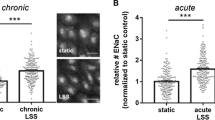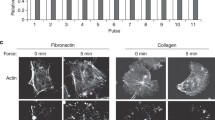Abstract
In the vascular endothelium, mechanical cell stiffness (К) and nitric oxide (NO) release are tightly coupled. “Soft” cells release more NO compared to “stiff” cells. Currently, however, it is not known whether NO itself is the primary factor that softens the cells or whether NO release is the result of cell softening. To address this question, a hybrid fluorescence/atomic force microscope was used in order to measure changes in К and NO release simultaneously in living vascular endothelial cells. Aldosterone was applied to soften the cells transiently and to trigger NO release. NO synthesis was then either blocked or stimulated and, simultaneously, К was measured. Cell indentation experiments were performed to evaluate К, while NO release was measured either by an intracellular NO-dependent fluorescence indicator (DAF-FM/DA) or by NO-selective electrodes located close to the cell surface. After the application of aldosterone, К decreases, within 10 min, to 80.5 ± 1.7% of control (100%). DAF-FM fluorescence intensity increases simultaneously to 132.9 ± 2.2%, which indicates a significant increase in the activity of endothelial NO synthase (eNOS). Inhibition of eNOS (by N ω-nitro-l-arginine methyl ester) blocks the NO release, but does not affect the aldosterone-induced changes in К. Application of an eNOS-independent NO donor (NONOate/AM) raises intracellular NO concentration, but, again, does not affect К. Data analysis indicates that a decrease of К by about 10% is sufficient to induce a significant increase of eNOS activity. In conclusion, these nanomechanic properties of endothelial cells in vascular endothelium determine NO release, and not vice versa.







Similar content being viewed by others
References
Martin W, White DG, Henderson AH (1988) Endothelium-derived relaxing factor and atriopeptin II elevate cyclic GMP levels in pig aortic endothelial cells. Br J Pharmacol 93:229–239
Fleming I, Busse R (2003) Molecular mechanisms involved in the regulation of the endothelial nitric oxide synthase. Am J Physiol Regul Integr Comp Physiol 284:R1–R12
Sessa WC (2005) Regulation of endothelial derived nitric oxide in health and disease. Mem Inst Oswaldo Cruz 100(Suppl 1):15–18
Balligand JL, Feron O, Dessy C (2009) eNOS activation by physical forces: from short-term regulation of contraction to chronic remodeling of cardiovascular tissues. Physiol Rev 89:481–534
Rubanyi GM, Romero JC, Vanhoutte PM (1986) Flow-induced release of endothelium-derived relaxing factor. Am J Physiol 250:H1145–H1149
Kuchan MJ, Frangos JA (1994) Role of calcium and calmodulin in flow-induced nitric oxide production in endothelial cells. Am J Physiol 266:C628–C636
Nilius B, Droogmans G (2001) Ion channels and their functional role in vascular endothelium. Physiol Rev 81:1415–1459
Oberleithner H, Callies C, Kusche-Vihrog K, Schillers H, Shahin V, Riethmuller C, MacGregor GA, de Wardener HE (2009) Potassium softens vascular endothelium and increases nitric oxide release. Proc Natl Acad Sci USA 106:2829–2834
Oberleithner H, Riethmuller C, Schillers H, MacGregor GA, de Wardener HE, Hausberg M (2007) Plasma sodium stiffens vascular endothelium and reduces nitric oxide release. Proc Natl Acad Sci USA 104:16281–16286
Oberleithner H, Schneider SW, Albermann L, Hillebrand U, Ludwig T, Riethmuller C, Shahin V, Schafer C, Schillers H (2003) Endothelial cell swelling by aldosterone. J Membr Biol 196:163–172
Kidoaki S, Matsuda T (2007) Shape-engineered vascular endothelial cells: nitric oxide production, cell elasticity, and actin cytoskeletal features. J Biomed Mater Res A 81:728–735
Kondrikov D, Han HR, Block ER, Su Y (2006) Growth and density-dependent regulation of NO synthase by the actin cytoskeleton in pulmonary artery endothelial cells. Am J Physiol Lung Cell Mol Physiol 290:L41–L50
Oberleithner H, Kusche-Vihrog K, Schillers H (2010) Endothelial cells as vascular salt sensors. Kidney Int 77:490–494
Callies C, Schon P, Liashkovich I, Stock C, Kusche-Vihrog K, Fels J, Strater AS, Oberleithner H (2009) Simultaneous mechanical stiffness and electrical potential measurements of living vascular endothelial cells using combined atomic force and epifluorescence microscopy. Nanotechnology 20:175104
Oberleithner H (2007) Is the vascular endothelium under the control of aldosterone? Facts and hypothesis. Pflugers Arch 454:187–193
Heylen E, Huang A, Sun D, Kaley G (2009) Nitric oxide-mediated dilation of arterioles to intraluminal administration of aldosterone. J Cardiovasc Pharmacol 54:535–542
Liu SL, Schmuck S, Chorazcyzewski JZ, Gros R, Feldman RD (2003) Aldosterone regulates vascular reactivity: short-term effects mediated by phosphatidylinositol 3-kinase-dependent nitric oxide synthase activation. Circulation 108:2400–2406
Schmidt BM, Sammer U, Fleischmann I, Schlaich M, Delles C, Schmieder RE (2006) Rapid nongenomic effects of aldosterone on the renal vasculature in humans. Hypertension 47:650–655
Fels J, Oberleithner H, Kusche-Vihrog K (2010) Ménage à trois: aldosterone, sodium and nitric oxide in vascular endothelium. Biochim Biophys Acta. doi:10.1016/j.bbadis.2010.03.006
Mutoh A, Isshiki M, Fujita T (2008) Aldosterone enhances ligand-stimulated nitric oxide production in endothelial cells. Hypertens Res 31:1811–1820
Asai M, Takeuchi K, Saotome M, Urushida T, Katoh H, Satoh H, Hayashi H, Watanabe H (2009) Extracellular acidosis suppresses endothelial function by inhibiting store-operated Ca2+ entry via non-selective cation channels. Cardiovasc Res 83:97–105
Itoh Y, Ma FH, Hoshi H, Oka M, Noda K, Ukai Y, Kojima H, Nagano T, Toda N (2000) Determination and bioimaging method for nitric oxide in biological specimens by diaminofluorescein fluorometry. Anal Biochem 287:203–209
Kojima H, Urano Y, Kikuchi K, Higuchi T, Hirata Y, Nagano T (1999) Fluorescent indicators for imaging nitric oxide production. Angew Chem Int Ed Engl 38:3209–3212
Pittner J, Wolgast M, Persson AE (2003) Perfusate composition influences nitric oxide homeostasis in rat juxtamedullary afferent arterioles. Acta Physiol Scand 179:85–91
Fujita S, Roerig DL, Bosnjak ZJ, Stowe DF (1998) Effects of vasodilators and perfusion pressure on coronary flow and simultaneous release of nitric oxide from guinea pig isolated hearts. Cardiovasc Res 38:655–667
Levine DZ, Iacovitti M, Burns KD, Zhang X (2001) Real-time profiling of kidney tubular fluid nitric oxide concentrations in vivo. Am J Physiol Renal Physiol 281:F189–F194
Carl P, Schillers H (2008) Elasticity measurement of living cells with an atomic force microscope: data acquisition and processing. Pflugers Arch 457:551–559
Kasas S, Dietler G (2008) Probing nanomechanical properties from biomolecules to living cells. Pflugers Arch 456:13–27
Grinspan JB, Mueller SN, Levine EM (1983) Bovine endothelial cells transformed in vitro by benzo(a)pyrene. J Cell Physiol 114:328–338
Kojima H, Hirata M, Kudo Y, Kikuchi K, Nagano T (2001) Visualization of oxygen-concentration-dependent production of nitric oxide in rat hippocampal slices during aglycemia. J Neurochem 76:1404–1410
Park JM, Higuchi T, Kikuchi K, Urano Y, Hori H, Nishino T, Aoki J, Inoue K, Nagano T (2001) Selective inhibition of human inducible nitric oxide synthase by S-alkyl-l-isothiocitrulline-containing dipeptides. Br J Pharmacol 132:1876–1882
Heinz WF, Hoh JH (1999) Spatially resolved force spectroscopy of biological surfaces using the atomic force microscope. Trends Biotechnol 17:143–150
Mathur AB, Collinsworth AM, Reichert WM, Kraus WE, Truskey GA (2001) Endothelial, cardiac muscle and skeletal muscle exhibit different viscous and elastic properties as determined by atomic force microscopy. J Biomech 34:1545–1553
Iyer S, Gaikwad RM, Subba-Rao V, Woodworth CD, Sokolov I (2009) Atomic force microscopy detects differences in the surface brush of normal and cancerous cells. Nat Nanotechnol 4:389–393
Kasas S, Wang X, Hirling H, Marsault R, Huni B, Yersin A, Regazzi R, Grenningloh G, Riederer B, Forro L, Dietler G, Catsicas S (2005) Superficial and deep changes of cellular mechanical properties following cytoskeleton disassembly. Cell Motil Cytoskeleton 62:124–132
Schmidt BM, Oehmer S, Delles C, Bratke R, Schneider MP, Klingbeil A, Fleischmann EH, Schmieder RE (2003) Rapid nongenomic effects of aldosterone on human forearm vasculature. Hypertension 42:156–160
Uhrenholt TR, Schjerning J, Hansen PB, Norregaard R, Jensen BL, Sorensen GL, Skott O (2003) Rapid inhibition of vasoconstriction in renal afferent arterioles by aldosterone. Circ Res 93:1258–1266
Cucina A, Sterpetti AV, Pupelis G, Fragale A, Lepidi S, Cavallaro A, Giustiniani Q, Santoro DL (1995) Shear stress induces changes in the morphology and cytoskeleton organisation of arterial endothelial cells. Eur J Vasc Endovasc Surg 9:86–92
Schnittler HJ, Schneider SW, Raifer H, Luo F, Dieterich P, Just I, Aktories K (2001) Role of actin filaments in endothelial cell–cell adhesion and membrane stability under fluid shear stress. Pflugers Arch 442:675–687
Lang F, Busch GL, Ritter M, Volkl H, Waldegger S, Gulbins E, Haussinger D (1998) Functional significance of cell volume regulatory mechanisms. Physiol Rev 78:247–306
Cornet M, Lambert IH, Hoffmann EK (1993) Relation between cytoskeleton, hypo-osmotic treatment and volume regulation in Ehrlich ascites tumor cells. J Membr Biol 131:55–66
Pedersen SF, Mills JW, Hoffmann EK (1999) Role of the F-actin cytoskeleton in the RVD and RVI processes in Ehrlich ascites tumor cells. Exp Cell Res 252:63–74
Knudsen HL, Frangos JA (1997) Role of cytoskeleton in shear stress-induced endothelial nitric oxide production. Am J Physiol 273:H347–H355
Su Y, Edwards-Bennett S, Bubb MR, Block ER (2003) Regulation of endothelial nitric oxide synthase by the actin cytoskeleton. Am J Physiol Cell Physiol 284:C1542–C1549
Schneider M, Ulsenheimer A, Christ M, Wehling M (1997) Nongenomic effects of aldosterone on intracellular calcium in porcine endothelial cells. Am J Physiol 272:E616–E620
Trepat X, Deng L, An SS, Navajas D, Tschumperlin DJ, Gerthoffer WT, Butler JP, Fredberg JJ (2007) Universal physical responses to stretch in the living cell. Nature 447:592–595
Takeda Y (2004) Vascular synthesis of aldosterone: role in hypertension. Mol Cell Endocrinol 217:75–79
Acknowledgment
Work was supported by the graduate program “Cell Dynamics and Disease,” University of Münster (international PhD scholarship to first author) and by grants from the Deutsche Forschungsgemeinschaft (OB 63/17-1 and Koselleck Grant OB 63/18). We thank Prof. Hugh E. de Wardener, Imperial College, London, for critically reading the manuscript.
Ethical standards
This study was conducted complying current laws and ethical standards.
Conflict of interest
The authors declare that they have no conflict of interest.
Author information
Authors and Affiliations
Corresponding author
Rights and permissions
About this article
Cite this article
Fels, J., Callies, C., Kusche-Vihrog, K. et al. Nitric oxide release follows endothelial nanomechanics and not vice versa. Pflugers Arch - Eur J Physiol 460, 915–923 (2010). https://doi.org/10.1007/s00424-010-0871-8
Received:
Revised:
Accepted:
Published:
Issue Date:
DOI: https://doi.org/10.1007/s00424-010-0871-8




